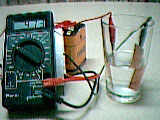


|
Water conductivity
Science at Home |
||
|
Materials
|
Compounds
|
Videos:
Pictures: 

|
|
Procedure
1. Using an electric string with crocodiles in the extremities, link the red pole string of the voltmeter to one of the copper electrodes. 2. With the other string, link the black pole (COM) of the voltmeter to the battery pole (-). 3. Using the third electric string link the battery pole (+) to the second copper electrode. 4. Dive the two copper electrodes in the glass distilled water (electrolyte). The electrodes shouldn't touch each other. (you can verify that the voltmeter indicates an lower value compared to the electric potential produced by the battery) 5. Move the electrodes (copper sheets) away from each other. (you can verify that the potential of the circuit will decrease) 6. Finally, without disturbing the system, add a teaspoon of sodium chloride (common salt) to the water. (you can verify that the potential of the circuit increases immediately to the supplied by the battery) |
||
|
Why?
With this simple experiment you can verify that the distilled water presents a very low conductivity because the potential of the first circuit is much less than the developed by the battery. The small potential of this circuit is due to the presence of the H+ and OH- ions produced when some molecules of water are dissociated. However, the number of molecules of water that are dissociated is practically negligible, making the distilled water a weak electrons conductor. It is worth noting, that as the distance among electrodes increases, the resistance to the electrons transfer in the distilled water increases considerably. This fact evidences even more the low conductivity of the distilled water. When salt is added (NaCl) to the system, the conductivity of the system increases considerably. The water not only dissolves the salt, as well as it dissociates the salt molecule. The elementary sodium (Na) presents an excess electron and the chloride (Cl) has a strong affinity for electrons. Consequently, after dissociation, the sodium loses an electron to the chloride, forming Cl- and Na+ ions. The presence of these ions increases the conductivity of the water considerably. The positive ions (Na+) migrate to the negative electrode (linked to the pole - of the battery) and the negatives (Cl-) migrate to the positive electrodes (linked to the pole + of the pile). The conductivity of the aqueous solution water/salt is proportional to the ions concentration in the solution. |
||
 |
No part of this website can be reproduced without previous authorization. Please inform me if there is any problem with the website. |